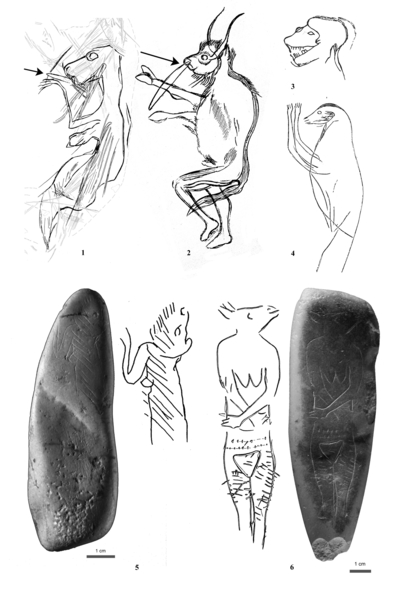- Home
- The engraved pebble from Étiolles
- Comparisons and interpretations
- Elsewhere at the same time
While it is unique at Étiolles, the engraved pebble is nonetheless typical of the Magdalenian culture. It is therefore interesting to look at similar objects on other sites from that time.
The Magdalenian horse
There is a certain level of realism in the horses engraved on the Étiolles pebble, something which is a common feature in Magdalenian art. However, its slender shape and elongated limbs, as well as the absence of a thick coat, distinguish it from typical depictions of horses in Magdalenian art, in which horses are bearded, with round stomachs and short legs.
1 and 2: The two Étiolles horses
3: The Paloma (on a small tablet)
4: Gönnersdorf (on a small tablet)
5: Andernach (on a small tablet)
6: Les Trois Frères (on a wall)
7: La Pasiega (on a wall)
8: Niaux (on a wall)
9: Les Combarelles (on a wall)
© copies by I. Barandiaran; G. Bosinski and G. Fischer; G. Bosinski and P. Schiller; H. Breuil
Horses in the Paris Basin
It is difficult to make comparisons due to the rarity of works within the Paris Basin. However, there are four horses (two heads on small rock fragments and two cave paintings) which are worth mentioning.
The horse’s head on flint cortex from Pincevent (Seine-et-Marne) is more recent, dating from the Azilian culture. Graphic details demonstrating the animal’s coat distinguish it from the Étiolles horses. In terms of rupestrian art, there is the horse, painted in red on a block of sandstone, found in 1954 in a quarry at Boutigny (Essonne), and the equid engraved in the Ségognole shelter in the Trois Pignons massif at Noisy-sur-École (Seine-et-Marne). Despite the absence of archaeological context, the naturalism of the designs, as well as the painting technique at Boutigny, demonstrate a “Palaeolithic style” which distinguishes them from other local schematic engravings (from post-glacial periods, in particular the Mesolithic).
1: Boutigny
2: Cepoy
3: La Ségognole
4: Pincevent
© cl. M.A.N.; copy G. Tosello; copy M.-A. Garcia; copy D. Baffier
The female figure
Therianthropes are one of the many chimeric creatures engraved on the walls of caves, notably at Les Trois-Frères (Ariège). Here, a spindle is engraved in front of the muzzle of a “man-bison” playing the nose flute, a detail also seen on the pebble at Étiolles. However, female figures are unusual in this type of representation, with only two figures known: in the Madeleine shelter (Dordogne) and the Tolentino shelter in Italy.
1: Étiolles
2: Les Trois-Frères (parietal art)
3: Massat (parietal art)
4: Altamira (parietal art)
5: La Madeleine (portable art)
6: Tolentino (portable art)
© Gilles Tosello; from copies by H. Breuil and M. Dauvois; copy Cl. Barrière; copy H. Breuil; doc. G. Tosello; doc. F. d’Errico



